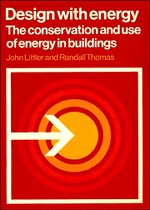Book contents
- Frontmatter
- Contents
- Units, symbols, abbreviations, conventions and conversion factors
- Preface
- 1 Energy and buildings
- 2 Site planning and analysis
- 3 Building design
- 4 Passive solar design
- 5 Active solar heating
- 6 Space heating and ventilation
- 7 Thermal storage
- 8 Wind energy
- 9 Water-supply systems
- 10 Waste disposal and utilization
- 11 Domestic-energy saving
- 12 Housing case studies
- 13 Non-domestic case studies
- Appendix 1 Weather data
- Appendix 2 Thermal performance
- Appendix 3 Interstitial condensation
- Index
6 - Space heating and ventilation
Published online by Cambridge University Press: 03 February 2010
- Frontmatter
- Contents
- Units, symbols, abbreviations, conventions and conversion factors
- Preface
- 1 Energy and buildings
- 2 Site planning and analysis
- 3 Building design
- 4 Passive solar design
- 5 Active solar heating
- 6 Space heating and ventilation
- 7 Thermal storage
- 8 Wind energy
- 9 Water-supply systems
- 10 Waste disposal and utilization
- 11 Domestic-energy saving
- 12 Housing case studies
- 13 Non-domestic case studies
- Appendix 1 Weather data
- Appendix 2 Thermal performance
- Appendix 3 Interstitial condensation
- Index
Summary
Introduction
From the underfloor heating of the Romans to the microbore hydronic installations of today may seem a small way but the path has been circuitous and the neglect of innovation has contributed to squandered resources and lowered living standards. For example, Fig. 6.1 shows an invention which was on the market in the early 1900s but failed to receive the attention it merited. The design is similar to the National Coal Board's present series of room heaters with back boilers. (Current designs include the safeguards of a vent behind the back boiler and a makeup tank.)
Prior to the 1950s, domestic heating in the UK was provided principally by open fires. Then, with rising prosperity, cheaper energy in the form of imported oil and technical advances such as small glandless centrifugal pumps designed to circulate small quantities of water against relatively high heads, central heating began to be adopted. In the past 30 years the percentage of the housing stock with central heating supplied by oil, gas or other fuel, has increased from about three to 50.121 Electricity for space heating also gained in popularity with the introduction of underfloor heating and storage heaters charged with cheaper night-time electricity.
This wide range of conventional heating systems developed for traditional houses is generally also applicable to low-energy buildings.
- Type
- Chapter
- Information
- Design with EnergyThe Conservation and Use of Energy in Buildings, pp. 189 - 240Publisher: Cambridge University PressPrint publication year: 1984

